Comprehensive Analysis of TBW Water Resources and GHG Emissions Report
VerifiedAdded on 2023/06/08
|8
|1754
|50
Report
AI Summary
This report examines the Tampa Bay Water (TBW) greenhouse gas (GHG) inventory, focusing primarily on scope 2 emissions from purchased electricity. It highlights the significance of electricity consumption in water treatment facilities, including raw water pumping, treatment processes, and sludge management, while excluding scope 1 emissions due to the absence of on-site power generation and disregarding scope 3 emissions like business travel and chemical consumption. The report details how TBW's GHG emissions are linked to production capacity and electricity usage across its facilities. The report includes a literature review that discusses the impact of energy consumption, location-based emissions, and the factors influencing emissions calculations, such as consumer demand and grid composition. Recommendations include methods for screening power emissions, utilizing postal codes to locate EPA sub-regions, using national average emission coefficients, and determining grid composition. The report emphasizes the need for accuracy and flexibility in emission calculations and provides equations and methods for estimating emissions, including those related to sludge disposal. The report concludes by stressing the importance of considering all contributing sources for accurate GHG emission assessments and suggests focusing on operational efficiency improvements, such as chemical usage, sludge management, and transmission loss reductions.
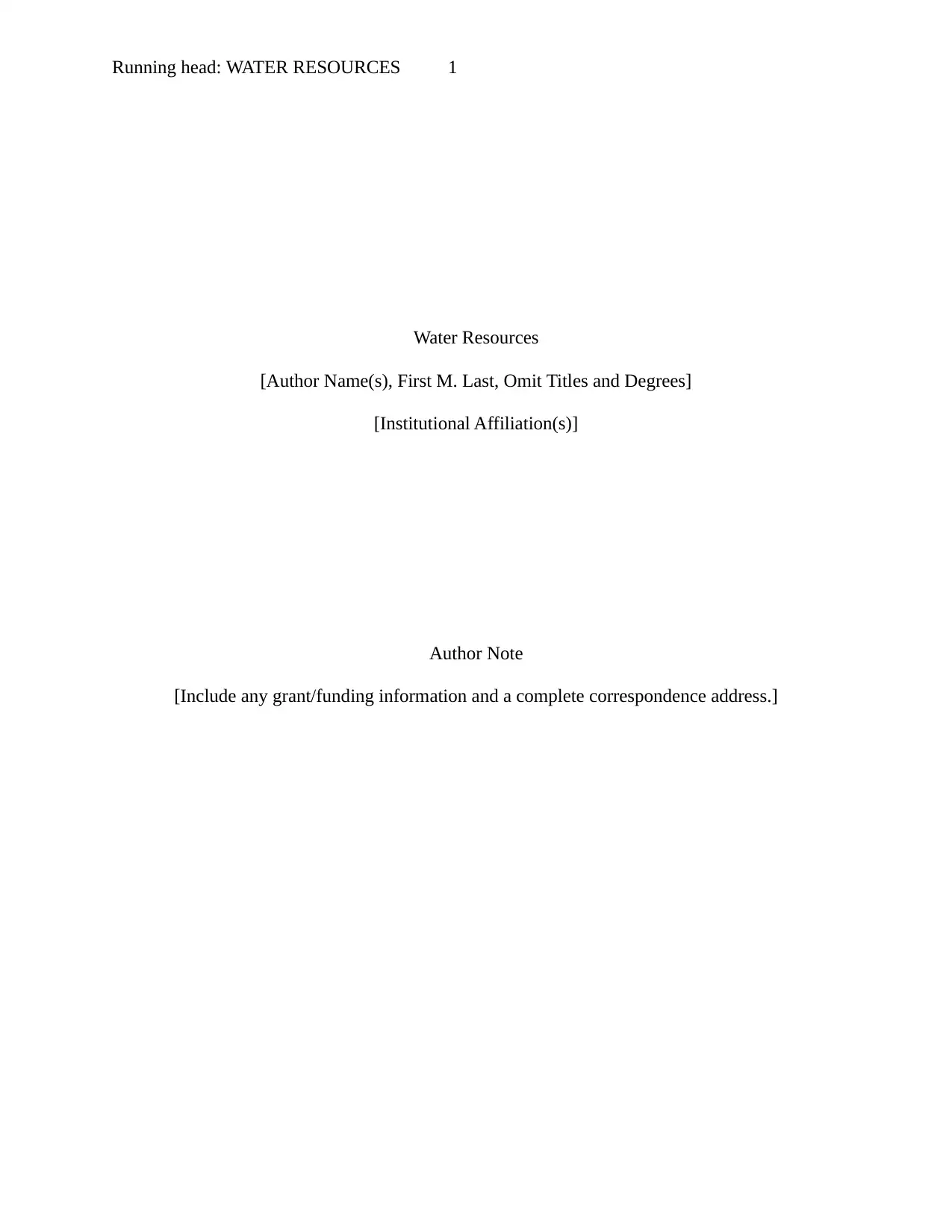
Running head: WATER RESOURCES 1
Water Resources
[Author Name(s), First M. Last, Omit Titles and Degrees]
[Institutional Affiliation(s)]
Author Note
[Include any grant/funding information and a complete correspondence address.]
Water Resources
[Author Name(s), First M. Last, Omit Titles and Degrees]
[Institutional Affiliation(s)]
Author Note
[Include any grant/funding information and a complete correspondence address.]
Paraphrase This Document
Need a fresh take? Get an instant paraphrase of this document with our AI Paraphraser
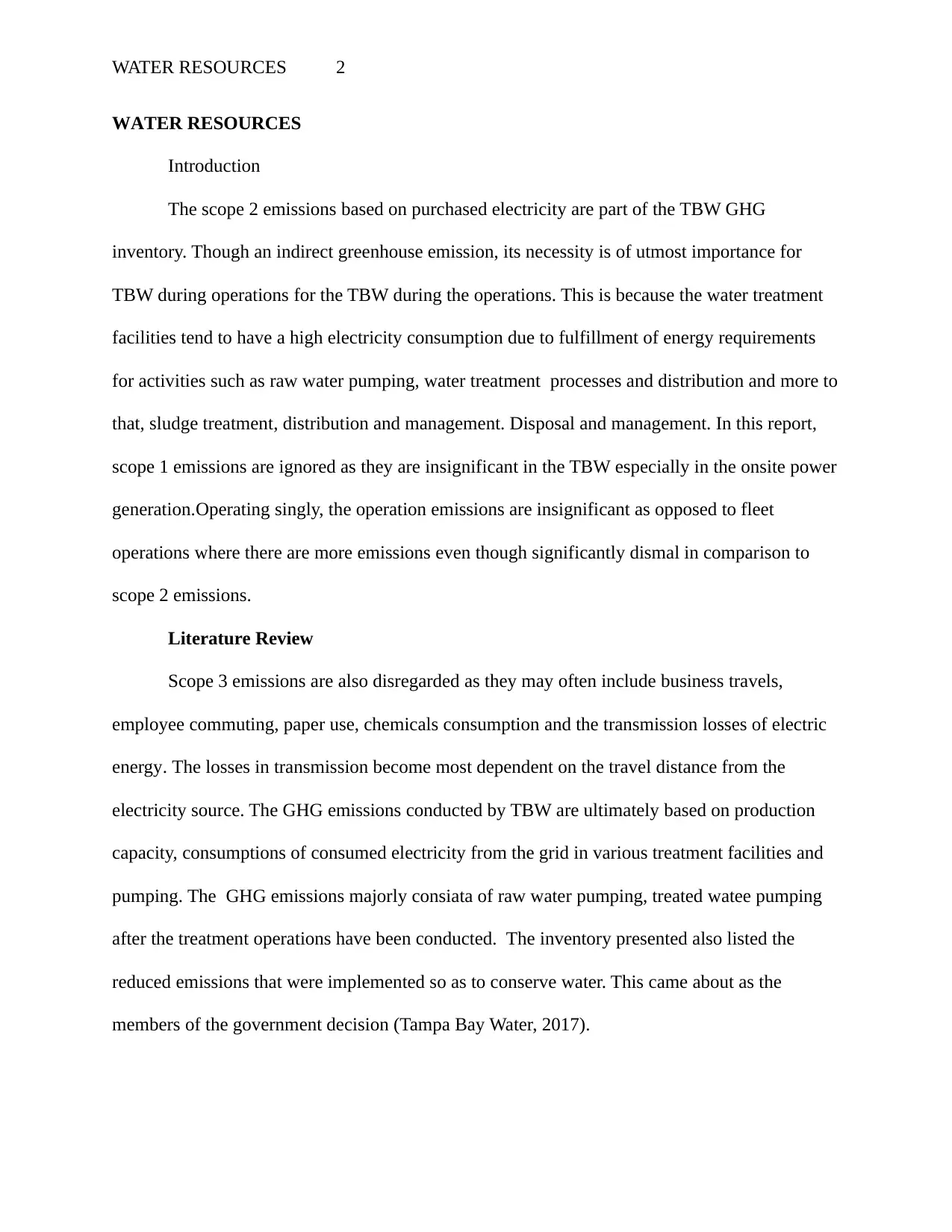
WATER RESOURCES 2
WATER RESOURCES
Introduction
The scope 2 emissions based on purchased electricity are part of the TBW GHG
inventory. Though an indirect greenhouse emission, its necessity is of utmost importance for
TBW during operations for the TBW during the operations. This is because the water treatment
facilities tend to have a high electricity consumption due to fulfillment of energy requirements
for activities such as raw water pumping, water treatment processes and distribution and more to
that, sludge treatment, distribution and management. Disposal and management. In this report,
scope 1 emissions are ignored as they are insignificant in the TBW especially in the onsite power
generation.Operating singly, the operation emissions are insignificant as opposed to fleet
operations where there are more emissions even though significantly dismal in comparison to
scope 2 emissions.
Literature Review
Scope 3 emissions are also disregarded as they may often include business travels,
employee commuting, paper use, chemicals consumption and the transmission losses of electric
energy. The losses in transmission become most dependent on the travel distance from the
electricity source. The GHG emissions conducted by TBW are ultimately based on production
capacity, consumptions of consumed electricity from the grid in various treatment facilities and
pumping. The GHG emissions majorly consiata of raw water pumping, treated watee pumping
after the treatment operations have been conducted. The inventory presented also listed the
reduced emissions that were implemented so as to conserve water. This came about as the
members of the government decision (Tampa Bay Water, 2017).
WATER RESOURCES
Introduction
The scope 2 emissions based on purchased electricity are part of the TBW GHG
inventory. Though an indirect greenhouse emission, its necessity is of utmost importance for
TBW during operations for the TBW during the operations. This is because the water treatment
facilities tend to have a high electricity consumption due to fulfillment of energy requirements
for activities such as raw water pumping, water treatment processes and distribution and more to
that, sludge treatment, distribution and management. Disposal and management. In this report,
scope 1 emissions are ignored as they are insignificant in the TBW especially in the onsite power
generation.Operating singly, the operation emissions are insignificant as opposed to fleet
operations where there are more emissions even though significantly dismal in comparison to
scope 2 emissions.
Literature Review
Scope 3 emissions are also disregarded as they may often include business travels,
employee commuting, paper use, chemicals consumption and the transmission losses of electric
energy. The losses in transmission become most dependent on the travel distance from the
electricity source. The GHG emissions conducted by TBW are ultimately based on production
capacity, consumptions of consumed electricity from the grid in various treatment facilities and
pumping. The GHG emissions majorly consiata of raw water pumping, treated watee pumping
after the treatment operations have been conducted. The inventory presented also listed the
reduced emissions that were implemented so as to conserve water. This came about as the
members of the government decision (Tampa Bay Water, 2017).
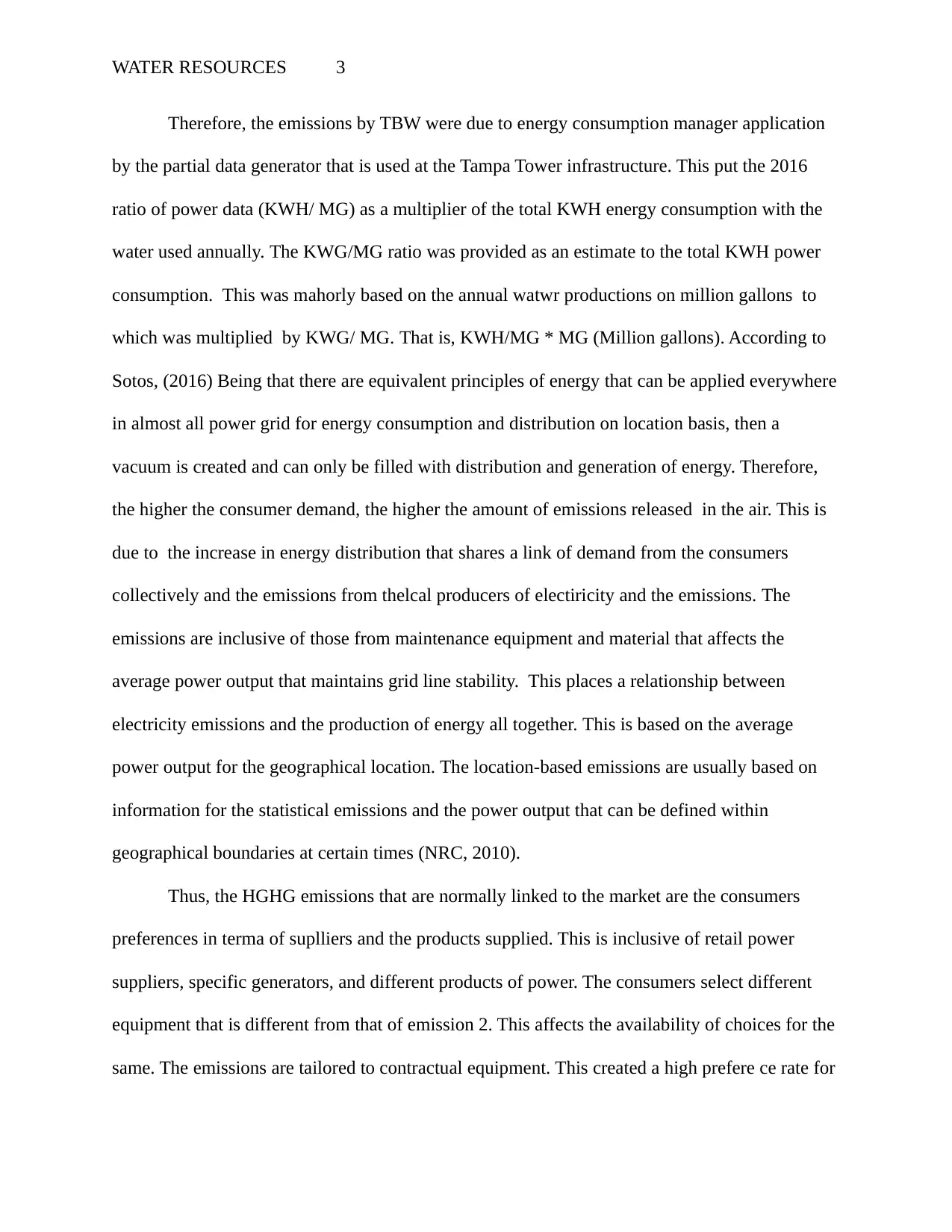
WATER RESOURCES 3
Therefore, the emissions by TBW were due to energy consumption manager application
by the partial data generator that is used at the Tampa Tower infrastructure. This put the 2016
ratio of power data (KWH/ MG) as a multiplier of the total KWH energy consumption with the
water used annually. The KWG/MG ratio was provided as an estimate to the total KWH power
consumption. This was mahorly based on the annual watwr productions on million gallons to
which was multiplied by KWG/ MG. That is, KWH/MG * MG (Million gallons). According to
Sotos, (2016) Being that there are equivalent principles of energy that can be applied everywhere
in almost all power grid for energy consumption and distribution on location basis, then a
vacuum is created and can only be filled with distribution and generation of energy. Therefore,
the higher the consumer demand, the higher the amount of emissions released in the air. This is
due to the increase in energy distribution that shares a link of demand from the consumers
collectively and the emissions from thelcal producers of electiricity and the emissions. The
emissions are inclusive of those from maintenance equipment and material that affects the
average power output that maintains grid line stability. This places a relationship between
electricity emissions and the production of energy all together. This is based on the average
power output for the geographical location. The location-based emissions are usually based on
information for the statistical emissions and the power output that can be defined within
geographical boundaries at certain times (NRC, 2010).
Thus, the HGHG emissions that are normally linked to the market are the consumers
preferences in terma of suplliers and the products supplied. This is inclusive of retail power
suppliers, specific generators, and different products of power. The consumers select different
equipment that is different from that of emission 2. This affects the availability of choices for the
same. The emissions are tailored to contractual equipment. This created a high prefere ce rate for
Therefore, the emissions by TBW were due to energy consumption manager application
by the partial data generator that is used at the Tampa Tower infrastructure. This put the 2016
ratio of power data (KWH/ MG) as a multiplier of the total KWH energy consumption with the
water used annually. The KWG/MG ratio was provided as an estimate to the total KWH power
consumption. This was mahorly based on the annual watwr productions on million gallons to
which was multiplied by KWG/ MG. That is, KWH/MG * MG (Million gallons). According to
Sotos, (2016) Being that there are equivalent principles of energy that can be applied everywhere
in almost all power grid for energy consumption and distribution on location basis, then a
vacuum is created and can only be filled with distribution and generation of energy. Therefore,
the higher the consumer demand, the higher the amount of emissions released in the air. This is
due to the increase in energy distribution that shares a link of demand from the consumers
collectively and the emissions from thelcal producers of electiricity and the emissions. The
emissions are inclusive of those from maintenance equipment and material that affects the
average power output that maintains grid line stability. This places a relationship between
electricity emissions and the production of energy all together. This is based on the average
power output for the geographical location. The location-based emissions are usually based on
information for the statistical emissions and the power output that can be defined within
geographical boundaries at certain times (NRC, 2010).
Thus, the HGHG emissions that are normally linked to the market are the consumers
preferences in terma of suplliers and the products supplied. This is inclusive of retail power
suppliers, specific generators, and different products of power. The consumers select different
equipment that is different from that of emission 2. This affects the availability of choices for the
same. The emissions are tailored to contractual equipment. This created a high prefere ce rate for
⊘ This is a preview!⊘
Do you want full access?
Subscribe today to unlock all pages.

Trusted by 1+ million students worldwide
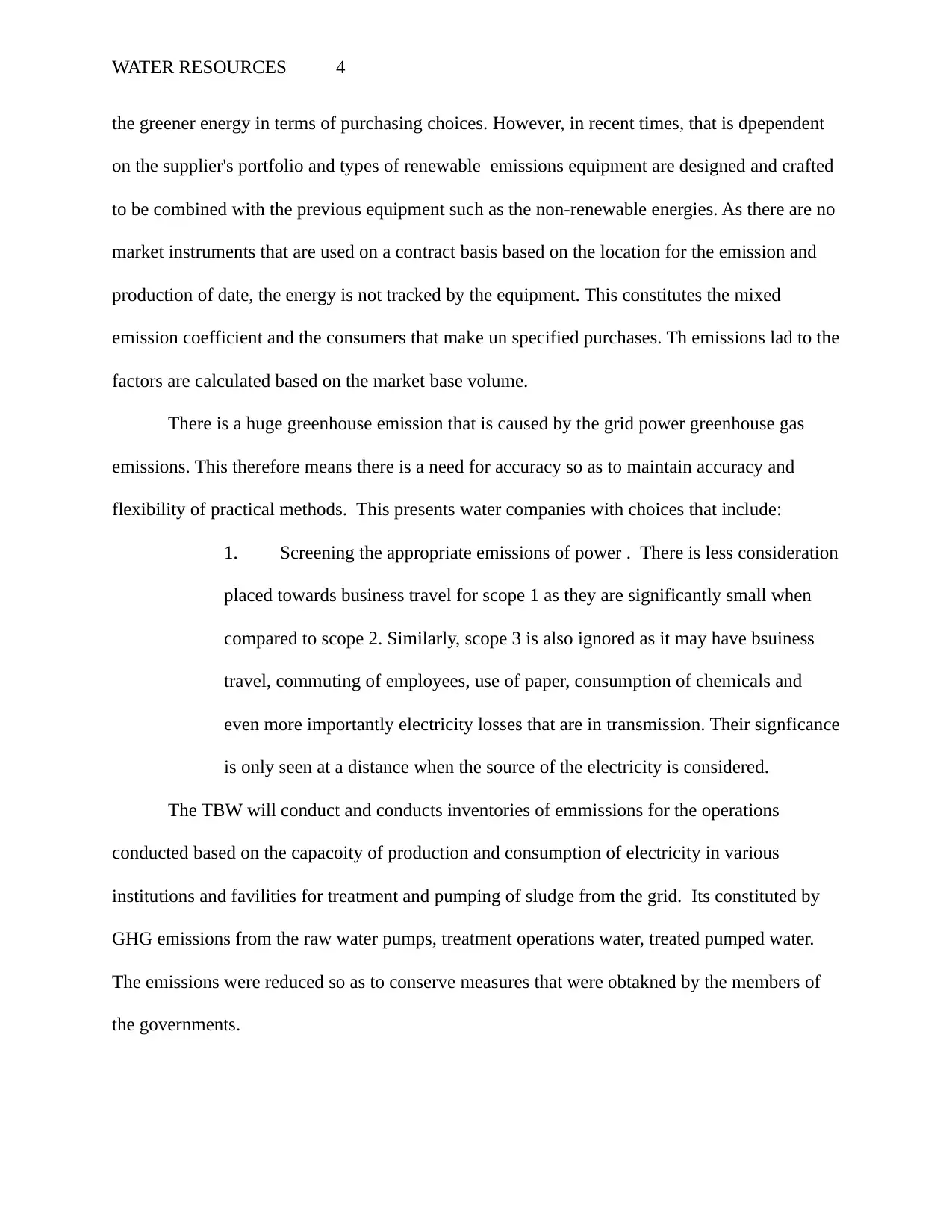
WATER RESOURCES 4
the greener energy in terms of purchasing choices. However, in recent times, that is dpependent
on the supplier's portfolio and types of renewable emissions equipment are designed and crafted
to be combined with the previous equipment such as the non-renewable energies. As there are no
market instruments that are used on a contract basis based on the location for the emission and
production of date, the energy is not tracked by the equipment. This constitutes the mixed
emission coefficient and the consumers that make un specified purchases. Th emissions lad to the
factors are calculated based on the market base volume.
There is a huge greenhouse emission that is caused by the grid power greenhouse gas
emissions. This therefore means there is a need for accuracy so as to maintain accuracy and
flexibility of practical methods. This presents water companies with choices that include:
1. Screening the appropriate emissions of power . There is less consideration
placed towards business travel for scope 1 as they are significantly small when
compared to scope 2. Similarly, scope 3 is also ignored as it may have bsuiness
travel, commuting of employees, use of paper, consumption of chemicals and
even more importantly electricity losses that are in transmission. Their signficance
is only seen at a distance when the source of the electricity is considered.
The TBW will conduct and conducts inventories of emmissions for the operations
conducted based on the capacoity of production and consumption of electricity in various
institutions and favilities for treatment and pumping of sludge from the grid. Its constituted by
GHG emissions from the raw water pumps, treatment operations water, treated pumped water.
The emissions were reduced so as to conserve measures that were obtakned by the members of
the governments.
the greener energy in terms of purchasing choices. However, in recent times, that is dpependent
on the supplier's portfolio and types of renewable emissions equipment are designed and crafted
to be combined with the previous equipment such as the non-renewable energies. As there are no
market instruments that are used on a contract basis based on the location for the emission and
production of date, the energy is not tracked by the equipment. This constitutes the mixed
emission coefficient and the consumers that make un specified purchases. Th emissions lad to the
factors are calculated based on the market base volume.
There is a huge greenhouse emission that is caused by the grid power greenhouse gas
emissions. This therefore means there is a need for accuracy so as to maintain accuracy and
flexibility of practical methods. This presents water companies with choices that include:
1. Screening the appropriate emissions of power . There is less consideration
placed towards business travel for scope 1 as they are significantly small when
compared to scope 2. Similarly, scope 3 is also ignored as it may have bsuiness
travel, commuting of employees, use of paper, consumption of chemicals and
even more importantly electricity losses that are in transmission. Their signficance
is only seen at a distance when the source of the electricity is considered.
The TBW will conduct and conducts inventories of emmissions for the operations
conducted based on the capacoity of production and consumption of electricity in various
institutions and favilities for treatment and pumping of sludge from the grid. Its constituted by
GHG emissions from the raw water pumps, treatment operations water, treated pumped water.
The emissions were reduced so as to conserve measures that were obtakned by the members of
the governments.
Paraphrase This Document
Need a fresh take? Get an instant paraphrase of this document with our AI Paraphraser
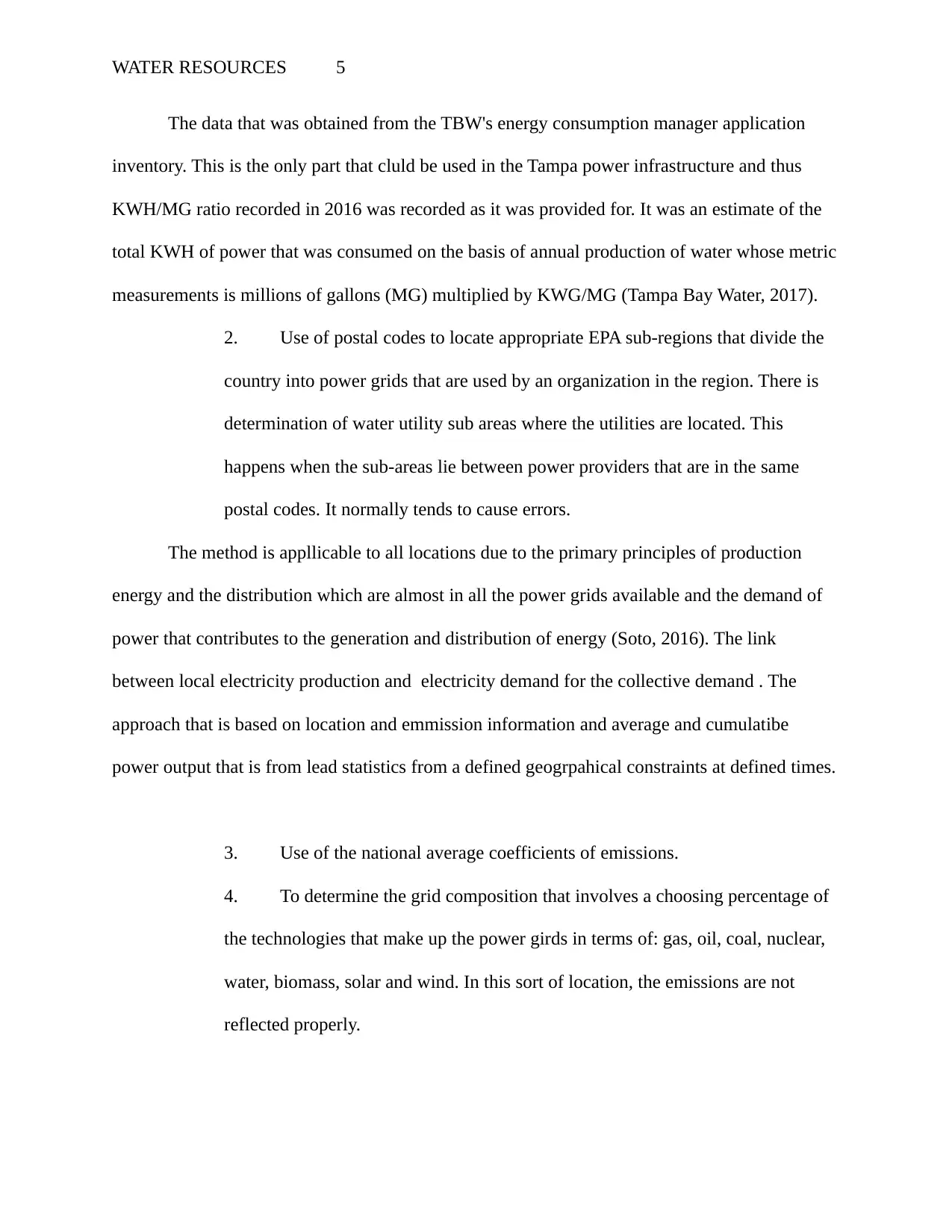
WATER RESOURCES 5
The data that was obtained from the TBW's energy consumption manager application
inventory. This is the only part that cluld be used in the Tampa power infrastructure and thus
KWH/MG ratio recorded in 2016 was recorded as it was provided for. It was an estimate of the
total KWH of power that was consumed on the basis of annual production of water whose metric
measurements is millions of gallons (MG) multiplied by KWG/MG (Tampa Bay Water, 2017).
2. Use of postal codes to locate appropriate EPA sub-regions that divide the
country into power grids that are used by an organization in the region. There is
determination of water utility sub areas where the utilities are located. This
happens when the sub-areas lie between power providers that are in the same
postal codes. It normally tends to cause errors.
The method is appllicable to all locations due to the primary principles of production
energy and the distribution which are almost in all the power grids available and the demand of
power that contributes to the generation and distribution of energy (Soto, 2016). The link
between local electricity production and electricity demand for the collective demand . The
approach that is based on location and emmission information and average and cumulatibe
power output that is from lead statistics from a defined geogrpahical constraints at defined times.
3. Use of the national average coefficients of emissions.
4. To determine the grid composition that involves a choosing percentage of
the technologies that make up the power girds in terms of: gas, oil, coal, nuclear,
water, biomass, solar and wind. In this sort of location, the emissions are not
reflected properly.
The data that was obtained from the TBW's energy consumption manager application
inventory. This is the only part that cluld be used in the Tampa power infrastructure and thus
KWH/MG ratio recorded in 2016 was recorded as it was provided for. It was an estimate of the
total KWH of power that was consumed on the basis of annual production of water whose metric
measurements is millions of gallons (MG) multiplied by KWG/MG (Tampa Bay Water, 2017).
2. Use of postal codes to locate appropriate EPA sub-regions that divide the
country into power grids that are used by an organization in the region. There is
determination of water utility sub areas where the utilities are located. This
happens when the sub-areas lie between power providers that are in the same
postal codes. It normally tends to cause errors.
The method is appllicable to all locations due to the primary principles of production
energy and the distribution which are almost in all the power grids available and the demand of
power that contributes to the generation and distribution of energy (Soto, 2016). The link
between local electricity production and electricity demand for the collective demand . The
approach that is based on location and emmission information and average and cumulatibe
power output that is from lead statistics from a defined geogrpahical constraints at defined times.
3. Use of the national average coefficients of emissions.
4. To determine the grid composition that involves a choosing percentage of
the technologies that make up the power girds in terms of: gas, oil, coal, nuclear,
water, biomass, solar and wind. In this sort of location, the emissions are not
reflected properly.
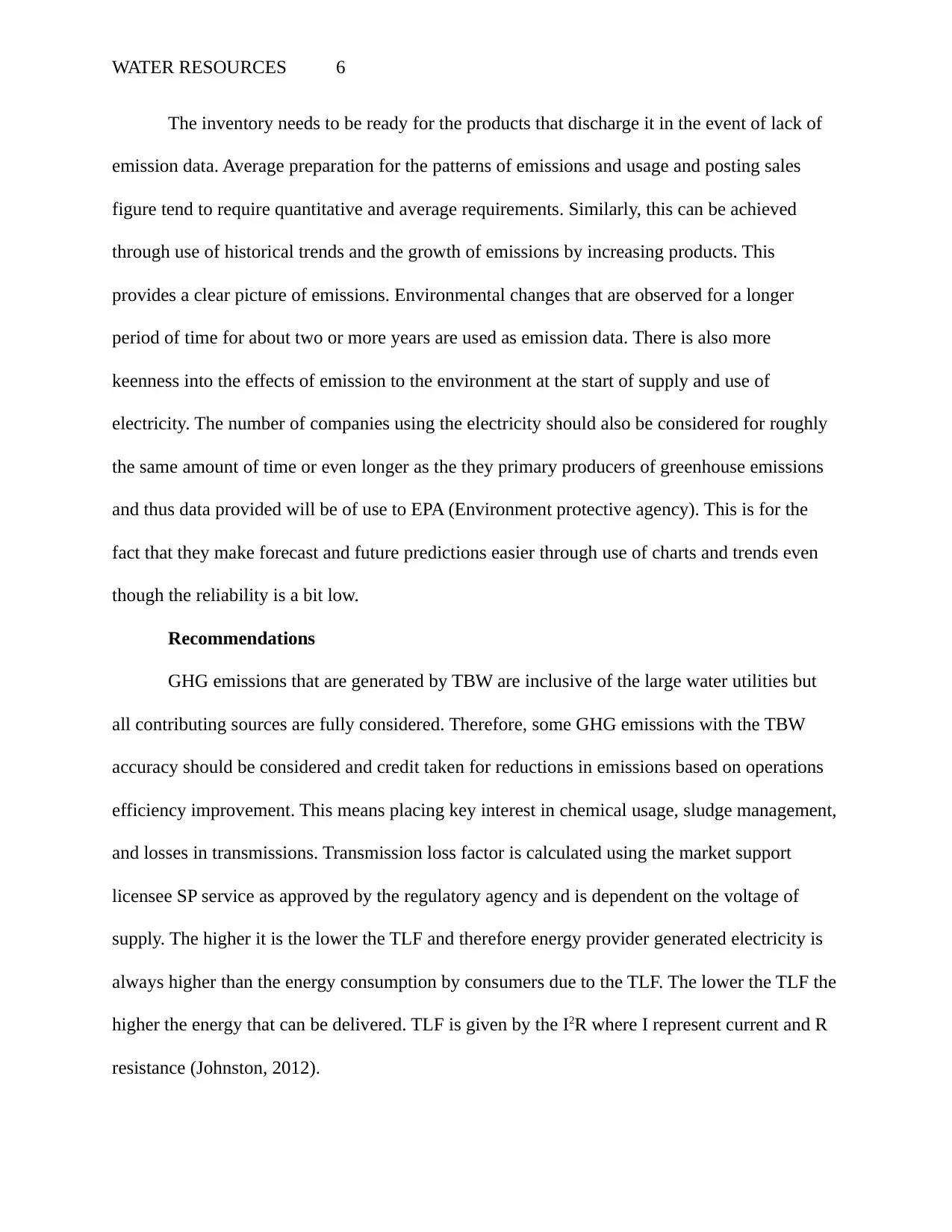
WATER RESOURCES 6
The inventory needs to be ready for the products that discharge it in the event of lack of
emission data. Average preparation for the patterns of emissions and usage and posting sales
figure tend to require quantitative and average requirements. Similarly, this can be achieved
through use of historical trends and the growth of emissions by increasing products. This
provides a clear picture of emissions. Environmental changes that are observed for a longer
period of time for about two or more years are used as emission data. There is also more
keenness into the effects of emission to the environment at the start of supply and use of
electricity. The number of companies using the electricity should also be considered for roughly
the same amount of time or even longer as the they primary producers of greenhouse emissions
and thus data provided will be of use to EPA (Environment protective agency). This is for the
fact that they make forecast and future predictions easier through use of charts and trends even
though the reliability is a bit low.
Recommendations
GHG emissions that are generated by TBW are inclusive of the large water utilities but
all contributing sources are fully considered. Therefore, some GHG emissions with the TBW
accuracy should be considered and credit taken for reductions in emissions based on operations
efficiency improvement. This means placing key interest in chemical usage, sludge management,
and losses in transmissions. Transmission loss factor is calculated using the market support
licensee SP service as approved by the regulatory agency and is dependent on the voltage of
supply. The higher it is the lower the TLF and therefore energy provider generated electricity is
always higher than the energy consumption by consumers due to the TLF. The lower the TLF the
higher the energy that can be delivered. TLF is given by the I2R where I represent current and R
resistance (Johnston, 2012).
The inventory needs to be ready for the products that discharge it in the event of lack of
emission data. Average preparation for the patterns of emissions and usage and posting sales
figure tend to require quantitative and average requirements. Similarly, this can be achieved
through use of historical trends and the growth of emissions by increasing products. This
provides a clear picture of emissions. Environmental changes that are observed for a longer
period of time for about two or more years are used as emission data. There is also more
keenness into the effects of emission to the environment at the start of supply and use of
electricity. The number of companies using the electricity should also be considered for roughly
the same amount of time or even longer as the they primary producers of greenhouse emissions
and thus data provided will be of use to EPA (Environment protective agency). This is for the
fact that they make forecast and future predictions easier through use of charts and trends even
though the reliability is a bit low.
Recommendations
GHG emissions that are generated by TBW are inclusive of the large water utilities but
all contributing sources are fully considered. Therefore, some GHG emissions with the TBW
accuracy should be considered and credit taken for reductions in emissions based on operations
efficiency improvement. This means placing key interest in chemical usage, sludge management,
and losses in transmissions. Transmission loss factor is calculated using the market support
licensee SP service as approved by the regulatory agency and is dependent on the voltage of
supply. The higher it is the lower the TLF and therefore energy provider generated electricity is
always higher than the energy consumption by consumers due to the TLF. The lower the TLF the
higher the energy that can be delivered. TLF is given by the I2R where I represent current and R
resistance (Johnston, 2012).
⊘ This is a preview!⊘
Do you want full access?
Subscribe today to unlock all pages.

Trusted by 1+ million students worldwide
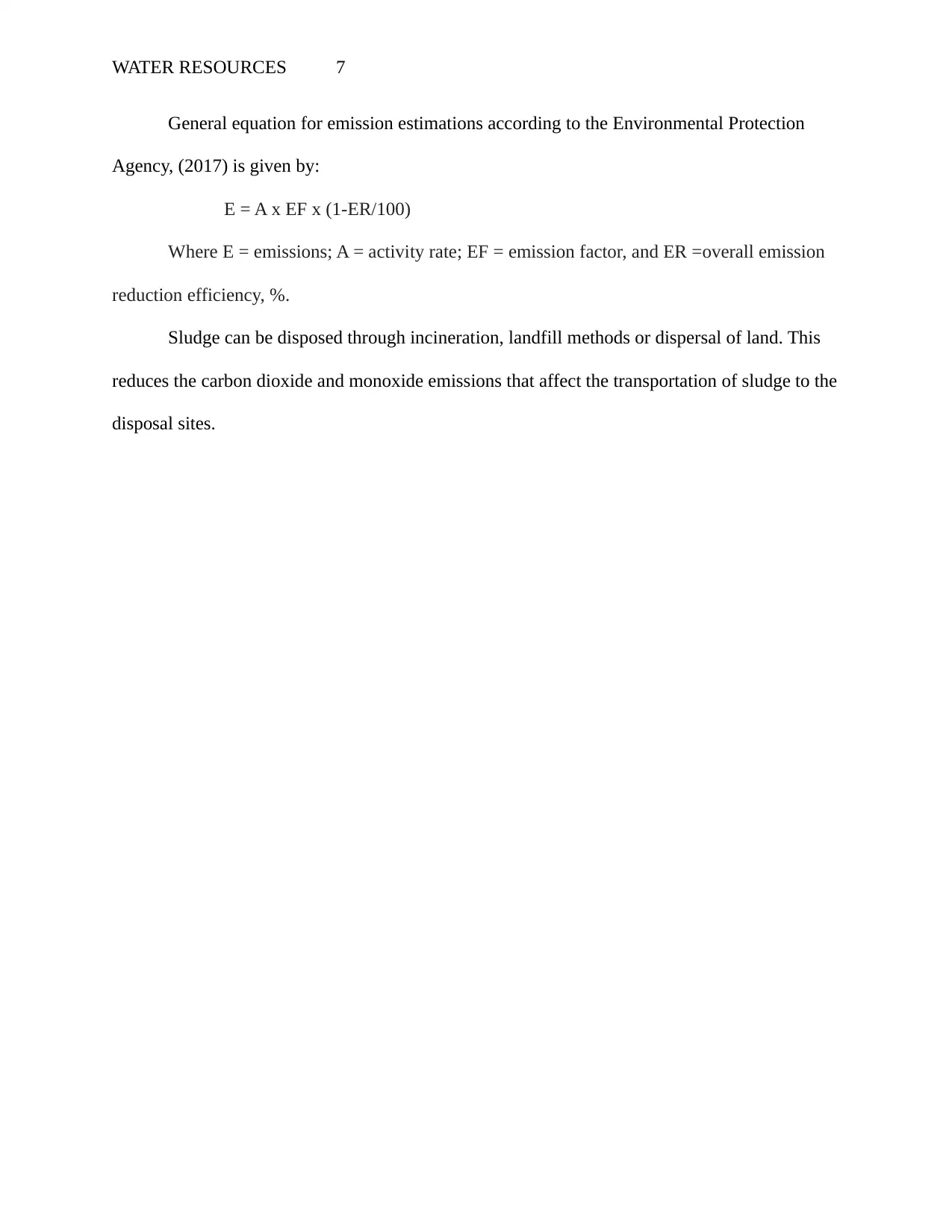
WATER RESOURCES 7
General equation for emission estimations according to the Environmental Protection
Agency, (2017) is given by:
E = A x EF x (1-ER/100)
Where E = emissions; A = activity rate; EF = emission factor, and ER =overall emission
reduction efficiency, %.
Sludge can be disposed through incineration, landfill methods or dispersal of land. This
reduces the carbon dioxide and monoxide emissions that affect the transportation of sludge to the
disposal sites.
General equation for emission estimations according to the Environmental Protection
Agency, (2017) is given by:
E = A x EF x (1-ER/100)
Where E = emissions; A = activity rate; EF = emission factor, and ER =overall emission
reduction efficiency, %.
Sludge can be disposed through incineration, landfill methods or dispersal of land. This
reduces the carbon dioxide and monoxide emissions that affect the transportation of sludge to the
disposal sites.
Paraphrase This Document
Need a fresh take? Get an instant paraphrase of this document with our AI Paraphraser

WATER RESOURCES 8
References
References
1 out of 8
Related Documents
Your All-in-One AI-Powered Toolkit for Academic Success.
+13062052269
info@desklib.com
Available 24*7 on WhatsApp / Email
![[object Object]](/_next/static/media/star-bottom.7253800d.svg)
Unlock your academic potential
Copyright © 2020–2025 A2Z Services. All Rights Reserved. Developed and managed by ZUCOL.



